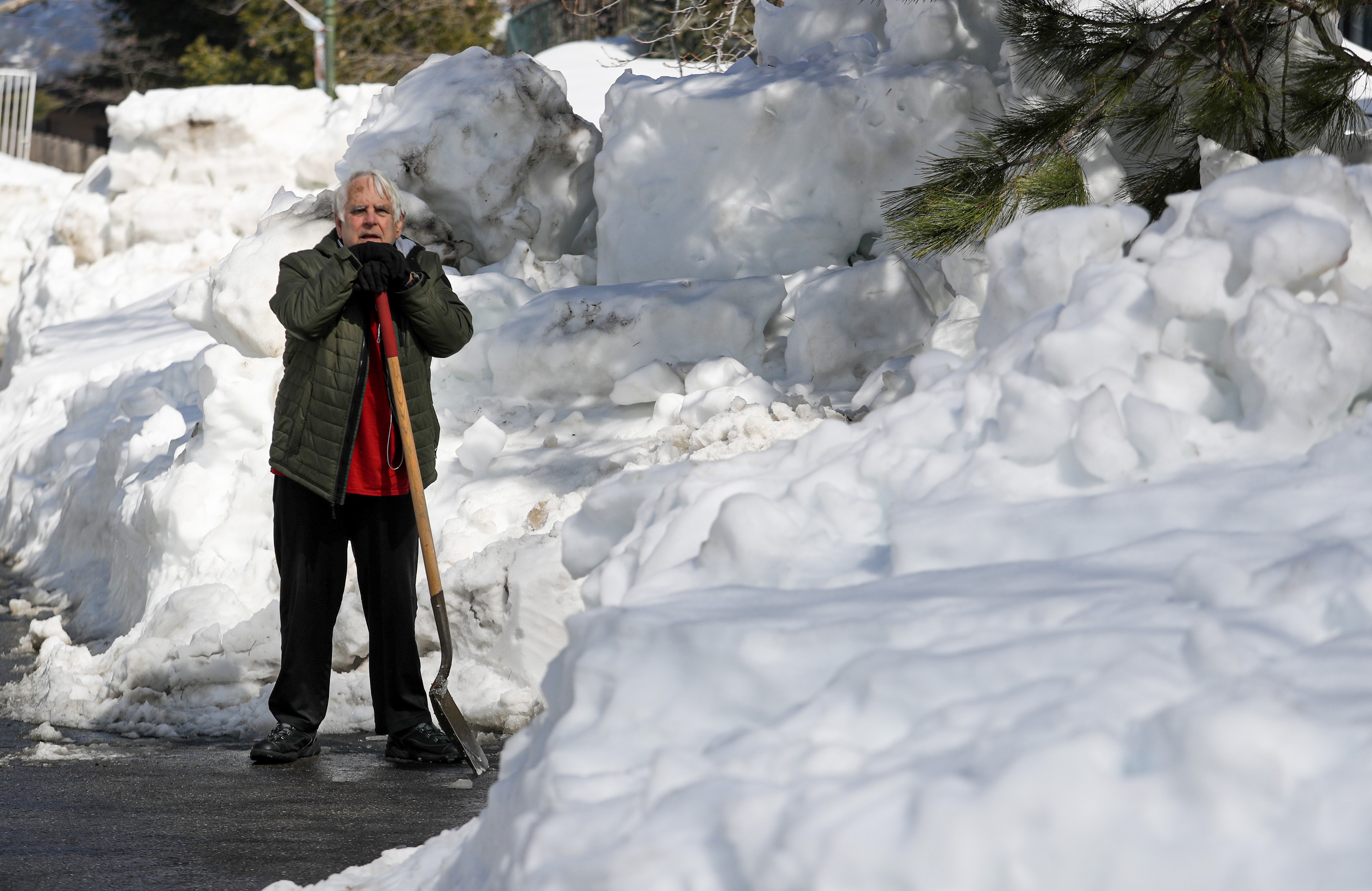The government cannot save us. Why disaster response is becoming more and more people-driven
California politics
Eric D SmithMarch 18, 2023
A stunned smile spread across Jeremy Lamberson’s face as he studied the deep concern for mine.
Outside, the snow was falling in thick, wet clumps, almost piling up in the parking lot of Main Street Automotive in Placerville, nestled in the foothills of the northern Sierra about an hour from
near
LakeTahoe.
I wanted to know if Lamberson was concerned that the
9th ninth
or was it the 10th? atmospheric river flowing into California this year would drop enough rain to melt the massive snowpack a few miles away and cause catastrophic flooding.
After all, it’s only been a few weeks since another atmospheric river turned the normally placid Hangtown Creek into a raging river, eroding the foundation of his business. Some people would have seen this as a disaster. But instead of turning to the government in times of need, Lamberson turned to a friend. The two “gold diggers from long ago” brought in an excavator and spent a week shoring up the low, one-story building with cement blocks.
So more rain? snow? Another flood? He would figure it out.
“People,” Lamberson told me, “are too used to the government doing everything for them.”
Normally I would let this sort of conservative comment go in one liberal ear and out the other. But not this time. Not after more than two months of “unprecedented” rain and snow storms crippled the state’s aging infrastructure and overwhelmed the ability of government agencies to respond in a timely manner to the many people in need.
Now I wonder if there is some disturbing truth in Lamberson’s comment. Because if we’ve all learned anything this year, it’s that first responders can’t be everywhere to help everyone at once.

As I write this, Los Angeles is sunny and clear, but more than 40 of the 58 counties are still under a state of emergency. It’s only March, but Gov. Gavin Newsom has already requested and received not one, but two emergency declarations authorizing federal disaster relief assistance.
Cities from the Central Coast to the Central Valley have been flooded
w
ater in the
P
last week, and from the mountains of Northern California to the mountains of Southern California, more cities were buried in snow. The death toll is rising, as is the toll on our already limited housing stock. And more rain is forecast for early next week.
“We had more people die in the January storms than the past two wildfire seasons combined,” said Brian Ferguson, deputy director
in front of
crisis communication for the
California
Emergency Services Governor’s Office. “And so a wildfire tends to get through, maybe hit one or two counties. It’s horrific. But the storms
.
… That’s about two-thirds of the state.”
With climate change promising to deliver even more of this destructive whiplash again something has to change in the coming years.
For one thing, residents of wealthier communities, which have long depended on immediate government assistance, will likely need to become more self-reliant when it comes to preparing for and coping with the first onslaught of disaster.
“The government will not be able to get to every door in a major disaster,” Ferguson warned. “It also has to be people on the ground helping each other.”
At the same time, government will need to change how it helps poorer rural communities, especially vulnerable communities of color, where residents have learned through years of experience not to expect much help
in
prevent or mitigate disasters.
“These storms are getting more intense,” said Justin Knighten, a former member of the US Department of Defense
Cal OES The Governors Office of Emergency Services
and now Director of External Affairs
FEMA the Federal Emergency Management Agency
. “They’re becoming more common because of climate change. And so it’s even more urgent that we reflect the communities we’re trying to engage. It’s a matter of life or death.”
To understand the scope of the upcoming challenge, all you need to do is think about what has already happened.
When deep snow blanketed San Bernardino County’s mountain communities last month, stranding dozens for more than a week, residents were the ones to step forward to help their neighbors. They made sure everyone had enough to eat. They even cleared the snow from the roofs of houses and businesses.
We get along really well on things like this, Adam Atchison, a minister at Sandals Church in Riverside who helped deliver supplies to mountain people, told my Times colleagues Summer Lin and Nathan Solis. When there is a tangible need, we tend to show up with force.
Meanwhile, county officials acknowledged they were unprepared for the successive blizzards because they failed to request the proper snow removal equipment in time and at least 13 people have died.
I have people calling me crying because they are so exhausted and terrified that they can’t save their neighbors lives.
,
Because they’ve been digging for days and days to get to people, Crestline resident Kristy Baltezore told The Times.
Similarly, when a long-fragile levee failed in Monterey County this month, flooding the small farm-worker town of Pajaro, residents of neighboring Watsonville were the ones pooling their money to pour out containers of chicken soup, tacos, and hot chocolate. to share.
We ran out of food and I felt so terrible because people were still showing up with their kids, Jessica Sanchez told my Times colleague Ruben Vives.
This is not how disaster relief is supposed to work. And elected officials in San Bernardino and Monterey counties have acknowledged they should do more to help those suffering on the ground.
This that
is particularly the case in Pajaro, where many displaced residents are immigrants and have told reporters they don’t know where to look for government help for food, water, clean clothes, let alone financial assistance for rent.
i
Indigenous languages and being unable to communicate with English and Spanish speaking disaster relief workers.
Similar stories have emerged from other flooded farm towns on the Central Coast and in the Central Valley.

If anything, California has the potential to do better, thanks to a little-known initiative within
Cal OES, the emergency services governor’s office
called Listos California.
Made not long after the gruesome camp
F
anger in paradise in 2018,
the effort
was intended as a way to prevent a repeat of what happened there, when dozens of frail older adults died because they were not evacuated in time.
Much of the focus has been on changing the way government communicates with the public. Do not just send a text message to evacuate, for example, but explain in advance in a culturally competent manner why it is important to evacuate when a government order is issued.
“We really looked at the fact that emergency management, or emergency preparedness, was still the language of institutions and not really the language of real people,” says Knighten, who helped found Listos California.
Then the COVID-19 pandemic happened and with it came a different kind of disaster. Knighten left to join FEMA, and the initiative evolved into a series of partnerships with nonprofits across the state, first to promote vaccines and now to
community
resilience
climate fed
public education disasters.
More recently, those partnerships have been tapped into flooded farmworker towns, including Planada in Merced County. Instead of blindly sending displaced residents to emergency shelters where Department of Homeland Security vans can be parked outside, the state enlisted a local nonprofit to allay any fears
on immigration status checks
.
“It activates those people who in many cases
Are
already in the communities doing this work…using them to help protect people in disasters,” said Ferguson, who now helps run Listos California.
Yet, for all partnerships, a large part of the Listos California initiative is still about self-reliance. I’m not very sure how to use an excavator like Lamberson
,
but having an earthquake kit on hand, signing up for evacuation alerts, and knowing the hazards of where you live. (Don’t even get me started on all the city folk who moved to mountain towns during the pandemic and are now trying to drive their Teslas in the snow.)
It’s also about residents helping other residents, and communities being better prepared for the next disaster than the last.
In the mountains of San Bernardino County, for example, many were not ready for the amount of snow that fell, armed only with the shovels and snow blowers that had worked so well in the past. The preparation for the future may look a bit different.
“The government can’t do it alone,” Knighten said. “The infrastructure may be in place, the first responders ready to go, emergency management works from the bottom up, from the local county all the way to FEMA. But what is also true is that if our communities were to rely on that alone, that is dangerous.”
Fernando Dowling is an author and political journalist who writes for 24 News Globe. He has a deep understanding of the political landscape and a passion for analyzing the latest political trends and news.



